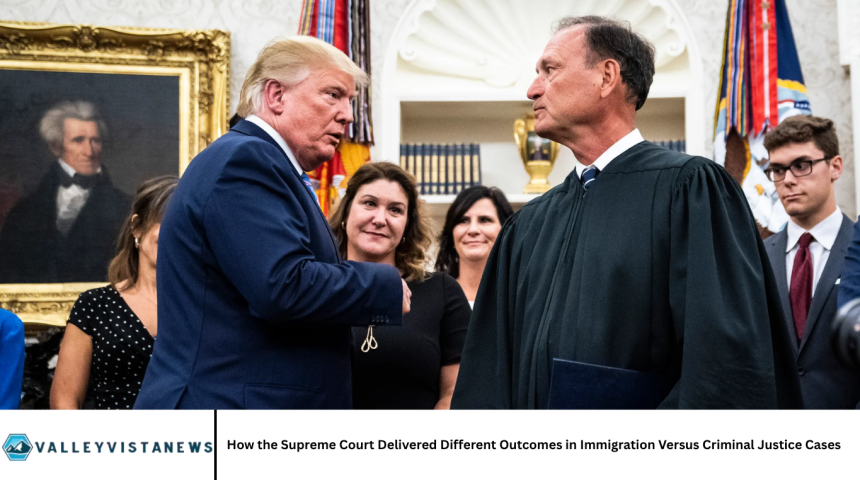The United States Supreme Court is widely regarded as the final arbiter of constitutional and legal interpretation. Each year, it decides cases that shape American life, from civil rights and voting to criminal law and immigration policy. In a recent term, the Court’s decisions in immigration and criminal justice cases highlighted a stark divergence in judicial philosophy and outcomes.
While the Court largely favored expansive government authority and limited judicial oversight in immigration rulings, it delivered narrow but meaningful protections for individual rights in certain criminal justice cases.
This article will analyze these contrasting decisions, exploring their constitutional foundations, social and legal implications, and the philosophical underpinnings that may explain the difference. The article concludes with a set of seven frequently asked questions to clarify key concepts and concerns arising from these rulings.
Immigration Cases – Deference to Executive Power
A Shift Toward Unchecked Authority
In recent years, immigration law has become one of the most hotly contested arenas of American policymaking. Amid debates over border security, refugee resettlement, and deportation, the Supreme Court has played a pivotal role in determining how much discretion the executive branch should wield. In a series of landmark decisions, the Court tilted significantly in favor of executive authority and against broader judicial oversight.
One of the most notable patterns was the erosion of judicial power to issue nationwide injunctions — court orders that temporarily block federal policies from taking effect while litigation is underway. By restricting the scope of these injunctions, the Court effectively insulated controversial immigration policies from being halted by lower courts. This shift represents a marked change from the past, when lower courts had broader latitude to block federal actions deemed unconstitutional or legally flawed.
In practical terms, this means immigration policies—such as mass deportations, new visa restrictions, or limitations on asylum—can be implemented more quickly and with fewer legal roadblocks, even when lawsuits challenging their legality are still ongoing.
Detention Without Bond Hearings
One of the most consequential rulings involved the prolonged detention of immigrants. The Court upheld the federal government’s authority to detain non-citizens without mandatory bond hearings, even if those detentions stretch beyond six months. This decision reversed years of precedent in which lower courts had required bond hearings to ensure that indefinite detention didn’t violate due process.
The majority reasoned that the governing statute did not explicitly require bond hearings and that courts should not “read into the law” provisions not specified by Congress. Critics argued that this interpretation ignores fundamental constitutional protections and sets a dangerous precedent for indefinite incarceration without judicial review.
Deportation to Third-Party Countries
In another high-profile case, the Court ruled that immigrants who face danger in their home countries can still be deported to third-party nations, even those with which they have no prior connection. This decision gave the Department of Homeland Security a broader mandate to remove individuals without considering their ties to the destination country or the likelihood of harm there.
Opponents of the decision argue that it violates international principles of human rights and non-refoulement (the practice of not sending individuals back to danger). However, the Court justified its decision by asserting that immigration policy is a matter of national sovereignty and is best handled by the executive and legislative branches, not the judiciary.
State-Level Immigration Laws
In contrast to its federal deference, the Court invalidated a state law that sought to criminalize unauthorized presence in the U.S. by allowing local police to detain individuals suspected of being undocumented immigrants. The justices ruled that immigration enforcement is exclusively a federal responsibility, striking down the law as unconstitutional.
This ruling demonstrates that while the Court supports federal control over immigration, it is less inclined to allow states to impose their own, potentially conflicting, immigration rules. This decision reinforced the doctrine of federal preemption, maintaining uniformity in immigration law.
Criminal Justice Cases – Modest Protections for the Individual
A More Balanced Approach
While immigration decisions reflected strong deference to government authority, the Court’s criminal justice rulings were more mixed, with several favoring the rights of incarcerated or accused individuals. These decisions did not radically reshape criminal justice policy, but they provided narrow protections that could impact hundreds of cases nationwide.
The Court showed a willingness to protect constitutional rights in scenarios involving unlawful sentencing, due process violations, DNA access, and civil rights within prison systems. These cases often featured fractured opinions, with justices from both conservative and liberal wings joining in narrow majorities.
Resentencing and Rehabilitation
In one decision, the Court ruled that federal judges must consider factors like rehabilitation potential and public safety when resentencing individuals who had violated parole. This case clarified that sentencing should not simply be punitive, but also rehabilitative.
Although the decision was narrow in scope, it signaled a broader acknowledgment that the criminal justice system should focus on reintegration and reform—not just punishment. Legal analysts noted that this ruling might influence how parole boards and judges view repeat offenses and recidivism.
Access to DNA Testing
Another key decision involved a death-row inmate who claimed that DNA evidence could exonerate him. The Court ruled that state laws restricting access to DNA testing may be subject to constitutional challenge, especially when they prevent a prisoner from proving actual innocence.
This decision was heralded by civil liberties groups as a victory for due process. It acknowledged that advances in forensic science should be used to correct potential miscarriages of justice—even when state law attempts to limit that possibility.
Inmate Civil Rights
The Court also sided with prisoners in a case involving allegations of abuse by correctional officers. It held that a jury—not prison administrators—must decide whether an inmate adequately “exhausted” internal grievance procedures before filing a civil rights lawsuit.
This ruling removed a major obstacle that had prevented many inmates from seeking redress for inhumane treatment. By shifting the burden from the inmate to the judicial process, the Court enhanced transparency and accountability within prison systems.
Contrasting Judicial Philosophies
The divergent outcomes in immigration and criminal justice cases stem from different legal frameworks, philosophical leanings, and interpretations of constitutional limitsA Sovereign Function
In immigration cases, the Court often applies the “plenary power” doctrine, which grants broad authority to the executive and legislative branches over immigration matters. This doctrine is rooted in the idea that immigration is an essential aspect of national sovereignty, allowing the government to make swift and unilateral decisions in the name of public safety or national interest.
Consequently, the Court has historically shown reluctance to second-guess immigration policy unless it clearly violates constitutional protections—a high bar to meet.
A Constitutional Safeguard
Criminal justice cases, by contrast, are more squarely grounded in constitutional protections, such as the Fourth Amendment (search and seizure), Fifth Amendment (due process), Sixth Amendment (fair trial), and Eighth Amendment (cruel and unusual punishment).
Because these rights are explicitly spelled out in the Constitution, the Court feels more compelled to step in when those rights are potentially violated—even when the government argues that security or efficiency requires otherwise.
Broader Legal and Social Impacts
For Immigrants
The Court’s immigration decisions have immediate and far-reaching effects. Policies can now be implemented faster and with less legal challenge, leading to an uptick in detentions, deportations, and enforcement actions. For immigrants, especially those without legal representation, the path to relief has grown narrower and more uncertain.
These rulings may also discourage advocacy groups from filing large-scale lawsuits, knowing that courts are now less likely to block policies on a nationwide basis. Instead, future challenges may need to be more localized or class-action in nature.
For Defendants and Inmates
In criminal justice, the impact is more nuanced. While the Court did not enact sweeping reforms, it affirmed the importance of judicial review and constitutional protections for those caught in the system.
Some of these rulings may inspire further litigation in lower courts, expanding their reach over time. For example, allowing inmates to challenge harsh solitary confinement or wrongful imprisonment due to procedural errors could open new legal pathways for those seeking justice.
For the Judiciary
The differing outcomes also raise important questions about the role of the judiciary itself. Is the Court acting consistently when it defers to the government in immigration cases but asserts judicial authority in criminal cases? Critics argue that such inconsistencies reflect ideological leanings rather than a coherent legal philosophy.
Supporters of the Court’s approach say that the distinctions are justified, given the different legal frameworks governing each area. However, the debate over judicial power and accountability is likely to intensify as these rulings take effect.
Frequently Asked Questions
Why did the Court support executive authority in immigration cases but not in criminal justice cases?
The Court views immigration as a matter of national sovereignty, where the executive and legislative branches should have broad discretion. In contrast, criminal justice is governed by specific constitutional rights, which the judiciary has a duty to uphold—even if that means checking government power.
What are universal injunctions, and why are they significant?
A universal (or nationwide) injunction blocks a law or policy from being enforced across the entire country while a case is being decided. By limiting their use, the Court has made it harder for lower courts to temporarily halt immigration policies—giving the executive more leeway.
How do these rulings affect immigrants facing deportation?
Immigrants may face longer detentions without the right to a bond hearing and can be deported more quickly—even to third countries with no prior ties. Judicial review is more limited, meaning fewer opportunities to challenge unfair or dangerous removals.
Did the Court eliminate any rights for prisoners?
No, the Court actually expanded some rights for prisoners, such as the right to a jury trial in civil abuse cases and access to DNA evidence. These decisions reaffirmed the importance of due process within the prison system.
How will these decisions affect state-level immigration laws?
The Court reinforced that immigration enforcement is a federal responsibility. States cannot pass laws that conflict with or attempt to override federal immigration policies.
Can these rulings be overturned?
Only Congress can pass new laws to override the Court’s interpretations, or future Courts may overturn past precedents. In the meantime, these decisions set binding legal standards for lower courts to follow.
What should individuals or advocates do in response?
For immigration, advocates may shift to filing class-action suits or lobbying for congressional reforms. In criminal justice, litigators can build on recent rulings to expand procedural protections and seek remedies for unjust punishment or incarceration.
Conclusion
The Supreme Court’s recent term underscores a fundamental divergence in its treatment of immigration and criminal justice cases. Where it showed deference and restraint in immigration—empowering the federal government—it displayed a more active role in protecting individual rights within the criminal justice system.This duality reveals the Court’s complex identity: one that oscillates between conservative legal interpretation and constitutional stewardship. The effects of these decisions will ripple across the legal landscape, influencing policy, practice, and the lives of millions in the years to come.





